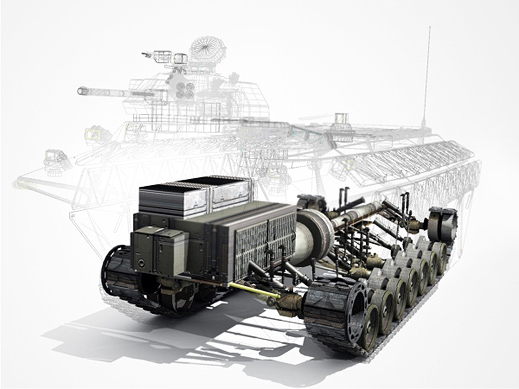DARPA Wants to Remake Manufacturing
The Defense Advanced Research Projects Agency (DARPA) is launching a $300 million collection of research efforts that could change the way the military models, designs, and ultimately manufactures its next generation of vehicles and weaponry. The program aims to develop a new amphibious tank in a collaborative process that allows designers to predict how all its components will interact before it is ever built.

Very few countries are able to manufacture military jets and warships that marry electronics, novel materials, and cutting-edge propulsion systems. Trouble often starts when a big project is divided into subsystems and farmed out. One team may design the engine, another the structure, and a third the electronics. Problems such as stress cracks may arise from the way those systems interact, but in many cases those problems don’t become apparent until a full prototype is actually built, triggering costly do-overs.
Consider the Pentagon’s effort to build the F-35 Joint Strike Fighter, a plane meant to be used by all branches of the military. The program has seen huge delays because of unexpected defects, like overheating caused by the hundreds of computer processors that run the jet’s avionics, communications, and weapons. The F-35 is now expected to cost $135 million per plane and $1.5 trillion over the life of the program, making it the most expensive weapons system in military history.
DARPA’s effort to design and build the amphibious assault vehicle is meant to test ideas for avoiding such problems in the future. Its goal is to begin producing two vehicles a week by 2016—a development process five times faster than what would be possible with the usual procurement methods.
The first phase of the project is a public design competition that began in January, offering $1 million to whoever submits the best design for the vehicles’ drivetrain. The competition is open to “anyone with a laptop” who resides in the U.S., according to DARPA, and the winning design will be assembled this summer at Rock Island Arsenal, a military base on an island in the Mississippi River. Similar contests will determine the designs of the chassis and armor.
To make sure these separately designed systems work together properly, DARPA is relying on software that can visualize the way they will interact in the tank. The agency also hopes to save money by using laser cutting and additive manufacturing—also called 3-D printing—to make complex shapes directly from designs.
Part of DARPA’s approach is to involve manufacturing experts—the ones who understand what factory-floor tools can and can’t do—at a very early stage. “Design is king, but the designers might not understand the implications of things like materials selection and tolerances or how systems interact,” says Mark Traband, head of the manufacturing systems division at Penn State’s Applied Research Laboratory, which won a $48 million contract from DARPA last summer.
After the agency picks a winning design for the vehicle’s chassis, Penn State will have seven days to estimate how much the chassis will cost to manufacture. The lab will also help build it. “Manufacturing engineers are often at the tail end of the design process,” says Traband. “Typically, when they get designs, they have to reëngineer them for manufacturability.”
Keep Reading
Most Popular
Large language models can do jaw-dropping things. But nobody knows exactly why.
And that's a problem. Figuring it out is one of the biggest scientific puzzles of our time and a crucial step towards controlling more powerful future models.
How scientists traced a mysterious covid case back to six toilets
When wastewater surveillance turns into a hunt for a single infected individual, the ethics get tricky.
The problem with plug-in hybrids? Their drivers.
Plug-in hybrids are often sold as a transition to EVs, but new data from Europe shows we’re still underestimating the emissions they produce.
Stay connected
Get the latest updates from
MIT Technology Review
Discover special offers, top stories, upcoming events, and more.